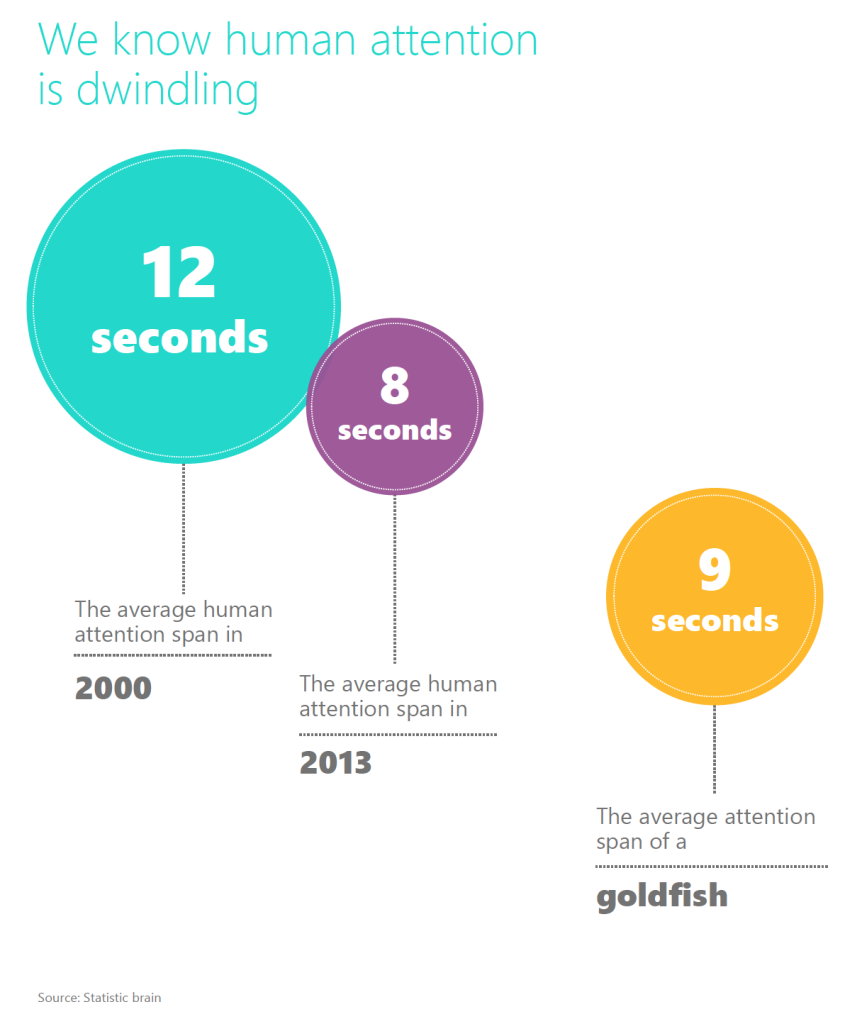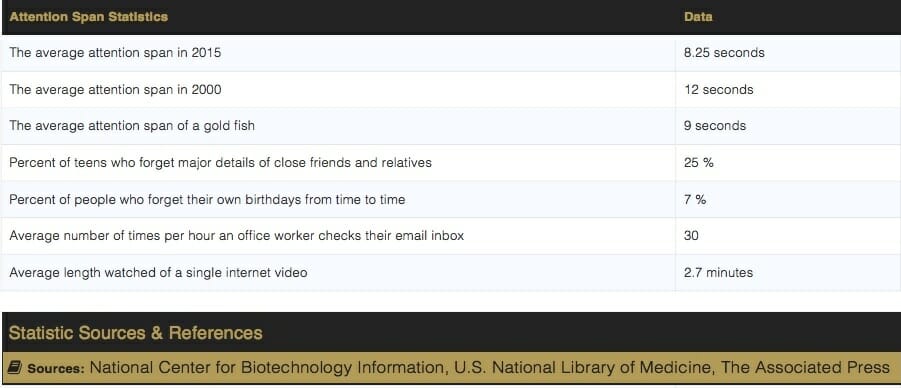
Articles
Industry News
Microlearning Essentials: The What and Why
By Sherman Morrison
October 09, 2017
Buzzwords come and buzzwords go with alarming frequency, but there are always some that end up sticking around for the long haul. Microlearning is definitely one of the hottest buzzwords in the eLearning industry, but will it make the cut for the long haul? Answers to the three questions posed in this article will shed some light on the topic microlearning essentials for learning and development professionals wondering whether or not they should jump onto the microlearning bandwagon.
1. Microlearning is Just Another Passing Fad, Right?
Wrong! Microlearning essentials begin with an understanding of why it is here to stay. There are several reasons, but none of them have anything to with humans now having shorter attention spans than the average goldfish (the answer to question 2 below debunks this pervasive myth). The primary reason microlearning is on the rise has to do with Millennials, now the largest living generation that is quickly becoming the largest percentage of the workforce as well. Microlearning works for Millennials because it fits with how they consume all kinds of digital media and information – in bite-sized chunks. But it’s not because they’re unable to focus their attention for longer periods of time; only that they’ve gotten used to smaller bits. But as it turns out, microlearning also works because it can be extremely effective. One recent study by Germany’s Dresden University of Technology noted that smaller chunks of content result in much better information retention across such aspects as overall comprehension, time taken to answer assessment questions, and amount of review needed. Combining all three aspects, microlearners did 22% better than longer-form learners.
2. Is Microlearning Needed Because of Shorter Attention Spans?
Short answer: No. This one is a little tricky, however, and requires a bit of explanation. Yes, you’ll find plenty of articles out there on the Internet that say microlearning is needed because of how short the human attention span has become in recent years. The “Goldfish Myth” states that the average human attention span is now just 8 seconds, which is less than the average attention of a goldfish, which supposedly clocks in at 9 seconds. Sounds compelling, but it’s not backed by scientific evidence.
The source of this latest iteration of the Goldfish Myth can be attributed to a Microsoft report published in 2015 called How Does Digital Affect Canadian Attention Spans? Keep in mind that the report (which can’t even be found online anymore) doesn’t have any author names, was not peer-reviewed, and was funded by an advertising office with a vested interested in grabbing people’s attention. It was based on research conducted by the Consumer Insights team at Microsoft Canada and included a survey administered to 2,000 Canadians as well as electroencephalogram (EEG) brain activity data collected from 112 people. Based on an analysis of this data, one of the conclusions reached in the report is this:
The study found early tech adopters and heavy social media users have more “intermittent bursts” of high attention. They’re better at identifying what they want/don’t want and need less to process and commit things to memory (source).
As previously mentioned, the general idea of microlearning is a good fit for tech-savvy digital natives like Millennials. The data did not reveal anything more specific about attention span, nor did it address the attention spans of goldfish. The report did, however, include the following graphic on page 6:

But these claims are not based on the research findings from Microsoft. The only citation given is Statistic Brain. Diving down the proverbial rabbit hole, the Statistic Brain website has a page of Attention Span Statistics that shows the following:

The first two sources listed sound promising, but the third is the Associate Press, and a news agency is rarely a good primary source. But none of them are hyperlinked, so they can’t even be verified. Digging further leads nowhere. There is literally no real scientific evidence to back up the claims. And just think about it – if our attention spans really were that short, how in the world could ever get anything done?
There is a much wider consensus, however, that humans do have a hard time sustaining focused attention on something for longer than 20 minutes. And we do that all the time as well. It’s easier to do, of course, when you like what you’re doing, but even when it’s something you have to do, you can hit the “reset” button on your attention span by taking a quick break and then coming back to the task. That’s the idea behind the Pomodoro Technique. Microlearning essentials take this idea to the next level by further shortening the length of time spent on any given learning resource or asset.
3. What Characteristics Define Microlearning Essentials?
Any attempt to adequately define microlearning essentials is difficult because there is no widespread consensus among learning professionals about what qualifies, so it does feel like a moving target. However, sifting through the best information sources out there does result in some common threads as described below:
Asset Duration. Some will say a microlearning asset should be less than five minutes while others say 5-10 minutes and yet others will say less than 15 minutes. Rather than focusing on trying to create some kind of hard-and-fast rule, it’s better to think in terms of “as long as necessary” or “right-sized” for the audience, content and learning objective. There is always going to be a need for longer courses and modules, but what microlearning challenges eLearning professionals to do is really break something down into the smallest core elements as possible. Take a 30-minute compliance course and break it down into 3 five-minute assets and suddenly people can grab each session whenever they have five minutes to spare. That’s microlearning in action.
One Learning Objective per Asset. Because the goal is the shortest duration possible, each asset can only address one objective. For a traditional course, there is usually a terminal objective, the big picture of what learners should be able to do or know at the end, as well as a bunch of smaller enabling objectives of specific skills that get them there. A microlearning asset must only address one enabling objective, and even those may need to be broken down into smaller objectives. Any time you can break an enabling objective down further, the better it will fit within microlearning essentials.
Accessibility. Millennials are especially vocal about wanting to have more control over what they learn and when they learn it, and microlearning has the potential to do exactly that. It needs to be easy to find and accessible from any type of device from desktops to laptops to tablets to phones and even wearables (watches, glasses, etc.). In essence, this is a significant shift towards a “pull” model as opposed to the more traditional “push” model of getting learning content out to learners. Instead, employees will pull in what they need to their device of choice when they need it, which means it needs to be as accessible as a conducting a quick Google search.
Interactivity. Traditional long-form approaches overload learners with content, which gets in the way of them interacting with the material. There’s no room for doing anything active with the content that would help learners make it their own and retain it because the goal is to keep plowing through all that material, thereby divorcing it from its application context.
Relevance. The best microlearning happens when a person encounters a problem or question and can immediately pull in a microlearning asset that addresses their issue. This can be thought of as “just-in-time” learning. And if the asset needed doesn’t exist, the company learning department should be able to create it quickly and efficiently. After all, it only needs to be a matter of minutes in terms of duration. But just because it’s short doesn’t mean it’s not a complete learning moment or cycle. When designed correctly, a microlearning asset is a bite-sized, highly relevant bit of learning content that can be immediately applied.
Microlearning essentials must begin with a better understanding of the what and why of microlearning. Microlearning is not a passing fad. If anything, it may well become the dominant form of learning, training and development as Millennials continue their rise as a percentage of the overall workforce. And the fact that the next generation won’t be any less digitally connected than Millennials also serves to reinforce the growth in microlearning, at least on topics where it makes sense. Just remember that microlearning works not because attention spans are shrinking, but because it’s an effective way to engage the way more and more people think and learn best.
Featured Image: Nordwood Themes, Unsplash.









[…] Of course, having more spare time isn’t the only thing that instructors want to get out of this monumental shift to online learning. But many other factors are tied to it, as educators (especially university professors) are often overworked and underpaid. […]